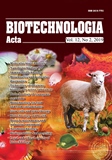ISSN 2410-776X (Online)
ISSN 2410-7751 (Print)

"Biotechnologia Acta" V. 12, No 2, 2019
Р. 71-78, Bibliography 20, English
Universal Decimal Classification: 663.1:631.363
https://doi.org/10.15407/biotech12.02.071
FERMENTATION OF SUGARCANE BAGASSE HYDROLYSATES BY Mucor indicus
Samara University, RF
The aim of the research was to analyze the fermentability of sugarcane bagasse prehydrolysates using Mucor indicus. The prehydrolysates were obtained by acid prehydrolysis of sugarcane bagasse and were detoxified before fermentation. A mold strain was also adapted to the inhibitors contained in the prehydrolysates. The production of ethanol and sugar consumption were investigated under aerobic and oxygen limited conditions. For the original strain, the consumption of sugars was incomplete and ethanol was produced at a yield of 0.39± (0,02) g g-1. The increased tolerance of M. indicus to the inhibitors resulted in a complete fermentation with total glucose consumption. Most of the xylose was consumed in all experiments, with the highest consumption in aerobic fermentations. Ethanol was the main product of fermentation and its yield was 0.41 ± (0,02) g g-1 at oxygen limited conditions and 0.37 ± (0,02) g g-1 at aerobic conditions. The use of other carbohydrates besides the monosaccharides was also investigated. Another advantage of M. indicus detected during the investigation was its ability to ferment pentoses, hexoses and oligosaccharides.
Key words: bioethanol, sugarcane bagasse, acid hydrolysis, Mucor indicus, filamentous fungi.
© Palladin Institute of Biochemistry of National Academy of Sciences of Ukraine, 2019
References
1. Rass-Hansen J., Falsig H., J?rgensen B., Christensen C. H. Perspective Bioethanol: fuel or feedstock? J. Chem. Technol. Biotechnol. 2007, V. 82, P. 329–333. https://doi.org/10.1002/jctb.1665
2. Ying Y., Teong L., Nadiah W. A., Pen C. The world availability of non-wood lignocellulosic biomass for the production of lignocellulosic ethanol and potential pretreatments for the enhancement of enzymatic saccharification. Renew. Sustain. Energy Reviews. 2016, V. 60, P. 155–172. https://doi.org/10.1016/j.rser.2016.01.072
3. Chandel A. K., Singh O. V., Venkateswar Rao L., Chandrasekhar G., Lakshmi Narasu M. Bioconversion of Novel Substrate Saccharum spontaneum, a Weedy Material, into Ethanol by Pichia stipitis NCIM3498. Bioresource Technol. 2011, V. 102, P. 1709–1714. https://doi.org/10.1016/j.biortech.2010.08.016
4. Mart?n C., L?pez Y., Plasencia Y., Hern?ndez E. Characterisation of Agricultural and Agro-Industrial Residues as Raw Materials for Ethanol Production. Chem. Biochem. Eng. 2006, 20 (4), 443–447.
5. Kumar A., Gautam A., Dutt D. Biotechnological Transformation of Lignocellulosic Biomass in to Industrial Products: An Overview. Adv. Biosci. Biotechnol. 2016, V. 7, P. 149–168. https://doi.org/10.4236/abb.2016.73014.
6. Puls J. Substrate analysis of forest and agricultural wastes, in Bioconversion of forest and agricultural residues, ed. by Saddler J. N. CAB Int., Wallingford. 1993, P. 13–32.
7. Hahn-H?gerdal B., Wahlbom C. F., Gardonyi M., van Zyl W. H., Cordero Otero R., J?nsson L. J. Metabolic engineering of Saccharomyces cerevisiae for xylose utilisation. Adv. Biochem. Eng. Biotechnol. 2001, V. 73, P. 53–84. https://doi.org/10.1007/3-540-45300-8_4
8. Karimi K., Brandberg T., Edebo L., Taherzadeh M. Fed-batch cultivation of M. indicus in diluteacid lignocellulosic hydrolyzate for ethanol production. Biotechnol. Lett. 2005, V. 6, P. 1395–1400. https://doi.org/10.1007/s10529-005-0688-2
9. Karimi K., Emtiazi G., Taherzadeh M. J. Production of ethanol and mycelial biomass from rice straw hemicellulose hydrolyzate by Mucor indicus. Proc. Biochem. 2006, V. 41, P. 653–658. https://doi.org/10.1016/j.procbio.2005.08.014
10. Millati R., Edebo L., Taherzadeh M. J. Performance of Rhizopus, Rhizomucor, and Mucor in ethanol production from glucose, xylose, and wood hydrolyzates. Enzyme Microb. Tech. 2005, V. 36, P. 294–300. https://doi.org/10.1016/j.enzmictec.2004.09.007
11. Millati R., Karimi K., Edebo L., Niklasson C., Taherzadeh M. J. Ethanol production from xylose and wood hydrolyzate by Mucor indicus at different aeration rates. BioResources. 2008, V. 3, P. 1020–1029.
12. Tang H., Hou J., Shen Y., Xu L., Yang H., Fang X., Bao X. High ?-glucosidase secretion in Saccharomyces cerevisiae improves the efficiency of cellulase hydrolysis and ethanol production in simultaneous saccharification and fermentation. J. Microbiol. Biotechnol. 2013, 23 (11), 1577–1585. https://doi.org/10.4014/jmb.1305.05011
13. Bharthare P., Singh P., Ttiwari A. Production of bioethanol with the aid of Mucor indicus by using peanut shell as substrate. Int. J. Adv. Res., IJOAR.org. 2016, 4 (12), 1–24. Online: ISSN 2320-916X
14. McIntyre M., Breum J., Arnau J., Nielsen J. Growth physiology and dimorphism of Mucor circinelloides during submerged batch cultivation. Appl. Microb. Biotechnol. 2002, V. 63, P. 495–502. https://doi.org/10.1007/s00253-001-0916-1
15. Sues A., Millati R., Edebo L., Taherzadeh M. J. Ethanol production from hexoses, pentoses, and dilute-acid hydrolyzate by Mucor indicus. FEMS Yeast Res. 2005, V. 5, P. 669–676. https://doi.org/10.1016/j.femsyr.2004.10.013
16. Ylitervo P. Production of ethanol and biomass from orange peel waste by Mucor indicus. M. S. thesis, University College of Bor?s, School of Engineering, Sweden. 2008, P. 1–61.
17. Lennartsson P. R. Zygomycetes and cellulose residuals: hydrolysis, cultivation and applications. PhD Thesis, Department of Chemical and Biological Engineering, Chalmers University of Technology, Sweden. 2012, P. 1–74.
18. Asadollahzadeh M. T., Ghasemian A., Saraeian A. R., Resalati H., Lennartsson P. R., Taherzadeh M. J. Ethanol and Biomass Production from Spent Sulfite Liquor by Filamentous Fungi. Int. J. Biol., Biomol., Agricult., Food Biotechnol. Engin. 2017, 11 (10), 653–659.
19. Karimi K., Zamani A. Mucor indicus: Biology and industrial application perspectives: A review. Biotechnol. Adv. 2013, 31 (4), 466–481. https://doi.org/10.1016/j.biotechadv.2013.01.009
20. Alriksson B., Sj?de A., Nilvebrant N. O., J?nsson L. J. Optimal conditions for alkaline detoxification of dilute-acid lignocelluloses hydrolysates. Appl. Biochem. Biotech. 2006, V. 130, P. 599–611. https://doi.org/10.1385/ABAB:130:1:599

